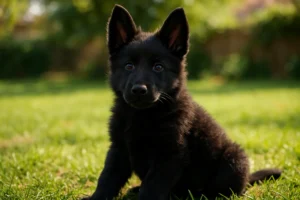Top 10 Commands Every Black German Shepherd Puppy Should Learn

black german shepherd puppy
Introduction
What Makes Black German Shepherds Special as Puppies
Black German Shepherd puppies are a striking and intelligent version of the classic German Shepherd breed. With their deep black coats and alert expressions, these puppies are more than just beautiful—they’re smart, loyal, and full of energy. They’re known for their strong work ethic, eagerness to please, and natural protectiveness. Because of their temperament, early and consistent obedience training is essential.
Why Early Training Is Crucial
Starting training early helps shape your Black German Shepherd puppy into a well-behaved adult. These dogs grow fast and are powerful, so laying down the rules during the puppy stage is much easier than correcting behaviors later. Basic puppy commands not only build obedience and safety but also help establish trust and clear communication with your puppy.

What This Guide Will Cover
In this guide, you’ll learn the top 10 commands every Black German Shepherd puppy should master, how to teach them, and why each one matters. We’ll also share german shepherd training tips, recommended tools, and bonus advice on socialization, consistency, and seeking help if needed.
Getting Started with Puppy Training
Ideal Age to Start Training Your Black German Shepherd Puppy
The best time to start training is between 8 and 12 weeks of age. At this stage, puppies are curious, open to new experiences, and ready to learn. While attention spans are short, they can absorb basic lessons quickly with positive reinforcement dog training.
Tools and Treats You’ll Need
Start with a few essentials to make training effective and enjoyable:
- High-value treats (tiny, soft, and irresistible)
- A clicker (optional, but helpful for marking behaviors)
- A comfortable leash and harness
- A quiet space free from distractions
Key Principles of Positive Reinforcement
Training should be fun and rewarding for your puppy. Keep these key principles in mind:
- Timing is everything: Reward or mark the behavior immediately.
- Consistency matters: Use the same words and cues every time.
- Reward over punishment: Focus on encouraging good behavior, not just correcting bad.
The Top 10 Commands Your Black German Shepherd Puppy Should Learn
Let’s break down each essential command and how to train it properly.
1. Sit
Why This Command Is Important:
“Sit” is the first building block for many other commands. It helps teach focus and patience.
How to Teach It Step-by-Step:
- Hold a treat close to your puppy’s nose.
- Slowly move it upward—your puppy’s head will follow, and their bottom will lower.
- Once seated, say “Sit,” then give the treat and praise.
Common Mistakes to Avoid:
Avoid saying the command repeatedly. Say it once, then guide with a treat.
Real-Life Use Cases:
Before crossing the street, greeting guests, or putting on a leash.
2. Stay
Why This Command Is Important:
“Stay” teaches impulse control training and helps prevent accidents, like dashing through doors.
How to Teach It Step-by-Step:
- Ask your puppy to sit.
- Hold your palm up and say “Stay.”
- Take one step back, then return and reward.
Common Mistakes to Avoid:
Don’t rush distance or duration. Build it up slowly.
Real-Life Use Cases:
At vet clinics, near roads, or during mealtime.
3. Come (Recall)
Why This Command Is Important:
A solid recall command for puppies can save your dog’s life. It also builds trust.
How to Teach It Step-by-Step:
- Start indoors with a short distance.
- Say “Come” in a cheerful voice.
- Reward with treats and praise immediately.
Common Mistakes to Avoid:
Never call your dog to scold them—they’ll learn to avoid you.
Real-Life Use Cases:
Off-leash parks, hikes, or backyard play.
4. Down
Why This Command Is Important:
Helps promote calmness and control.
How to Teach It Step-by-Step:
- Start with your dog in a sitting position.
- Move the treat down between their paws.
- Say “Down” as they lie flat.
Common Mistakes to Avoid:
Avoid pushing your puppy into position—use the treat to guide.
Real-Life Use Cases:
Vet visits, when guests arrive, or during overstimulation.
5. Leave It
Why This Command Is Important:
Teaches your puppy to avoid harmful or tempting items.
How to Teach It Step-by-Step:
- Place a treat in your closed hand.
- When your pup stops trying to get it, say “Yes” and reward with a different treat.
Common Mistakes to Avoid:
Don’t give the item you said “Leave it” for—that confuses the message.
Real-Life Use Cases:
When they find food on the ground or approach a dangerous object.
6. Drop It
Why This Command Is Important:
Essential for preventing chewing or swallowing dangerous items.
How to Teach It Step-by-Step:
- Offer a toy your puppy likes.
- While they hold it, offer a treat and say “Drop it.”
- When they release, reward them.
Common Mistakes to Avoid:
Never yank the item out of their mouth. That can cause resource guarding.
Real-Life Use Cases:
When they pick up socks, sticks, or trash.
7. Heel
Why This Command Is Important:
Encourages calm, controlled walking on a leash.
How to Teach It Step-by-Step:
- Keep your puppy at your side with a treat in hand.
- Say “Heel” and take a few steps.
- Reward frequently at your side.
Common Mistakes to Avoid:
Avoid using tension on the leash. It’s about engagement, not force.
Real-Life Use Cases:
Daily walks, public places, or busy streets.
8. No
Why This Command Is Important:
Provides a clear cue for undesired behavior.
How to Teach It Step-by-Step:
- Say “No” in a calm but firm tone.
- Redirect to a desired behavior.
- Reward when they comply.
Common Mistakes to Avoid:
Don’t yell or scare your puppy—this breaks trust.
Real-Life Use Cases:
Jumping, chewing, or nipping.
9. Watch Me (Focus Command)
Why This Command Is Important:
Improves focus exercises for German Shepherd puppies or King Shepherd puppies and attention span.
How to Teach It Step-by-Step:
- Hold a treat to your forehead or nose.
- Say “Watch Me” and reward when they make eye contact.
Common Mistakes to Avoid:
Don’t train this in noisy areas until the command is solid.
Real-Life Use Cases:
Before giving another command, during distractions.
10. Place
Why This Command Is Important:
Gives your puppy a safe, designated spot.
How to Teach It Step-by-Step:
- Guide them to a mat or bed.
- Say “Place” as they step on it.
- Reward and slowly increase duration.
Common Mistakes to Avoid:
Don’t use “Place” as a punishment—it should feel safe.
Real-Life Use Cases:
When guests visit, during meals, or when overstimulated.
Bonus Tips for Black German Shepherd Puppy Training
How Often to Train and for How Long

Short sessions are best. Aim for 5–10 minutes, 2–3 times per day. End on a positive note. Frequent, fun sessions help your puppy stay engaged and eager to learn.
Socialization Matters Too
Socializing your German Shepherd puppy is just as important as commands. Expose them to different people, dogs, sounds, and environments early. This reduces fear, anxiety, and reactivity later on.
When to Seek Help from a Professional Trainer
If your puppy:
- Shows aggression
- Ignores repeated commands
- Has trouble with leash training
- Doesn’t respond to rewards
…it might be time to work with a trainer experienced in large breed dogs or working dog breeds.
Conclusion
Training your Black German Shepherd puppy doesn’t have to be overwhelming. Focus on these 10 core commands—Sit, Stay, Come, Down, Leave It, Drop It, Heel, No, Watch Me, and Place. They build a strong foundation for obedience training, safety, and harmony at home.
Stay patient, be consistent, and always make it rewarding. Training is more than teaching—it’s bonding. Enjoy every moment with your growing pup!
FAQs About Black German Shepherd Puppy Training
How long does it take to train a Black German Shepherd puppy?
With consistent daily training, you’ll see progress within a few weeks. Mastery of all commands can take 4–6 months.
What’s the best age to teach advanced commands?
Once your puppy is fluent in basic commands (usually around 6 months), you can introduce advanced skills like scent work or agility.
Are Black German Shepherds harder or easier to train than others?
They’re typically easier to train due to their intelligence and eagerness to please. However, they need structure and mental stimulation.
Can I train my puppy without a professional trainer?
Yes! Many owners successfully train their puppies using reward-based training for dogs and online resources. But for behavioral issues or faster results, a professional trainer can help.




